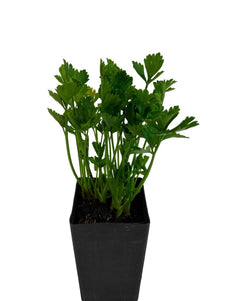
Chinese Celery
Chinese Celery
- In stock, ready to ship
- Inventory on the way

Usually available: All year
Life cycle: Annual
Height: 60cm
Position: Sun / part shade
Soil preference: Moist / well drained
This is how we pack and send your Herb Plants to all states except TAS & WA
You will receive
- 1 Celery for Cutting Herb Plant in a 50 X 75mm tube - General growing instructions
All of our Herb Plants are grown organically with certified organic potting mixes and fertilizers
Botanical Name: Apium graveolens var. secalinum
Chinese Celery is an herbaceous flowering biennial, growing from 60cm high and by 30cm wide. The whole plant is mid to dark green with quite a dense clumping appearance. The stems or stalks are thin and have the characteristic celery furrows. The large toothed leaves are quite glossy and held opposite, creating a lush presence. The tiny white flowers are held in small clusters and appear in summer. The whole plant has a distinct celery aroma when crushed.
The native habitat of the original Celery is found across Central and Southern Europe, especially the Mediterranean regions, and in the temperate regions of Africa and Asia. This plant is a moisture lover and it tends to grow near water course, drainage areas or other damp, marshy areas. It tolerates saline soil very well and often grows close to the sea in salt marshes. It has spread across the globe and is a weed in many countries, including parts of Australia. There are several sub species of this wild form of Celery and each is able to disperse many seeds each season. This ability to respond and adapt to new environments is responsible for its spread across the globe and its survival in new regions.
The scientific designation for Chinese Celery is Apium graveolens, with other common names of Wild Celery, Ajmod, Par-cel or Smallage. Modern celery goes by the same botanical name, but is distinguished by variety or sub species. Asian growers often call cutting celery by the names Kun Choi or Kin Tsai. Celery is related to carrots, dill, cumin and similar species from the Apiaceae family with the characteristic umbelliferous flowers.
This Celery species is one of the earliest known food plants with records of use from the 7th Century BC, from Egyptian tombs and from the time of Ancient Greece. In the 16th and 17th Centuries the first efforts to breed different varieties of Wild Celery began, leading to the modern cultivars found in today’s kitchen. The main difference is found in the appearance and size of the stems, strength of taste and the degree of acidity found in the plant. Modern varieties are sweeter and the thick stems are generally eaten, whereas with the Wild Celery it is the stronger tasting leaves that are often consumed.
Interestingly, Celery of all types belongs to a group of foods implicated in life threatening allergic reactions similar to that caused by peanuts. Although rare, in Europe, this Celery Allergy is significant to the same degree that Peanut Allergy is of concern in other Western Countries. Conversely, there is less Peanut Allergy in Europe.
Growing Conditions
Chinese Celery prefers it prefers to grow in full sun to part shade, so some overhead coverage is acceptable. It flowers during summer and is not considered frost tender. All soil types are tolerated, with sandy substrates being particularly useful for the reasonably shallow root system. It prefers moist soils with significant water and has a preference for growing in damp grounds. It is able to grow in saline or salt affected ground quite well. It spreads very easily and effort should be made to keep the plant within the home garden. It is considered to be useful in repelling insects in the garden and as a companion for leeks, tomato, French Beans and the Brassicas.
Culinary Uses
Chinese Celery may be used in any recipe calling for celery, such as stews, soups or vegetable dishes. Traditionally the stems are not often used except in small quantities in soups or stews. This species is popularly used in local French Cuisine. However, the leaves are used cooked or raw in a similar fashion to modern celery, for example in salads, seasonings and stews. The flavour is stronger than modern varieties and the taste is earthy, but pleasant. The roots and the seeds may also be cooked and consumed. The seeds contain high levels of anise flavoured oils and may be used as a spice. All parts of the plant may be used for juicing but the plant is considered toxic in large amounts.
Medicinal Uses
Chinese Celery, the precursor to modern celery, has a history of medicinal use stretching back for centuries. All parts of the plant are used in Traditional Chinese Medicine and it is considered a valuable herb for detoxifying the body and cleansing the blood and kidneys, use as a diuretic, to lower blood pressure and to treat arthritis and improve eyesight. It was also used in Ancient Ayurvedic Medicine for treating the common cold, flu symptoms, diseases of the liver, spleen and digestive function. It was also considered to be an anti-spasmodic, anti-inflammatory, a sedative and a regulator of menstrual cycles. The potential to affect the uterus means that it is not suitable for pregnant women in therapeutic amounts. Herbal tea may be made by infusing the seeds.
All information provided on this website is for informational purposes only. Please seek professional advice before commencing any treatment.




